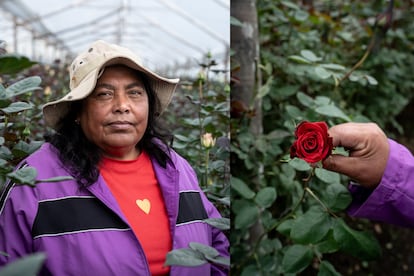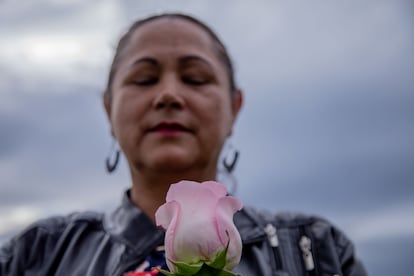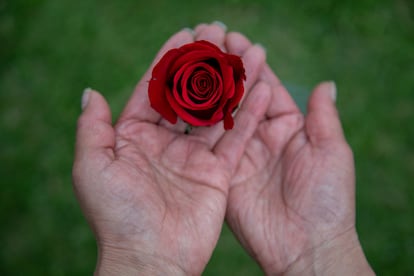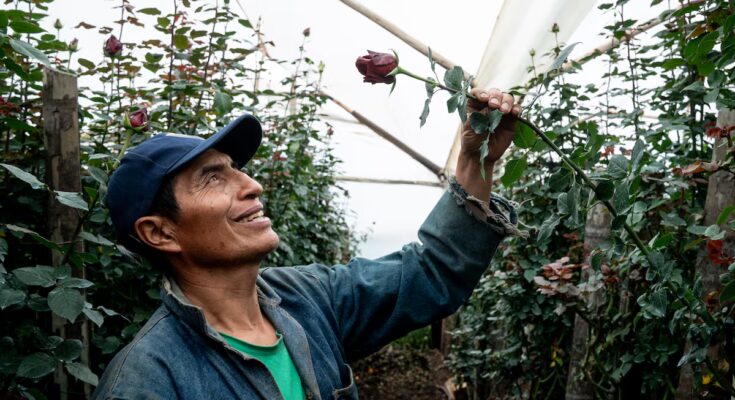EL PAÍS openly proposes the América Futura column for its daily and global informative contribution on sustainable development. If you want to support our journalism, subscribe Here.
On the road to Tabacundo, the landscape dominated by arid mountains begins to take over the greenhouses. This town of around 21,000 inhabitants, known as the “rose capital of the world”, belongs to the Pedro Moncayo canton of the province of Pichincha, is located 60 kilometers north of Quito and rises at 2870 meters above sea level. Since the 1980s its economy has turned to the production of roses. The determining factors in this impulse were the altitude, the temperate climate and the availability of sunlight up to 12 hours a day. But, as the report points out The flowers of evil: flower growers and their accelerated growthby the Azione Ecologica organisation, also the hiring of low-cost labour. Most workers earn a base salary of $470 (plus statutory benefits), while the cost of the basic family basket is $813. According to the Ministry of Productive Activities, at a national level women represent 51% of the workforce in this sector, and in that city they reach 60%.
It is estimated that between 4 and 5 million stems of around 400 varieties are produced every day. According to the private organization Expoflores (National Association of Flower Producers and Exporters of Ecuador), 75% of rose production is concentrated in the province of Pichincha and, of the total flower production at the national level, 77% corresponds to roses, which in 2024 placed Ecuador as the third largest exporter in the world, after the Netherlands and Colombia. That year, and for the first time, exports exceeded one billion dollars, “a very important milestone that marks the direction to follow,” says Alejandro Martínez, president of Expoflores. The three main destinations are the United States, the European Union and Kazakhstan, the country through which Russia has been supplied since it went to war with Ukraine.
Once in Tabacundo, all the signs of a town dedicated to floriculture appear: dilapidated greenhouses of some failed company, modest kiosks offering bouquets of 25 roses for a dollar, warehouses where tractors, pesticides, fumigation pumps, packaging materials and lots of plastic are sold. In the countryside, the acrid smell of the environment due to the intensive use of pesticides is also surprising. According to a study published in the scientific journal JMIR Publications, constant exposure to these products is associated with multiple health changes, including cognitive impairment, miscarriages, respiratory and skin diseases, prostate and breast cancer and leukemia. Furthermore, having to work between 8 and 10 hours a day on your feet can have an impact on muscles and joints, and it is normal for the constant pressure to achieve high productivity to cause work stress.
trade union organisation
In the center of the town is the headquarters of ASOTFLORPI, the Association of Floriculture Workers of Pichincha. It was founded in 2012 by Marcia Lema, a strong woman in every sense whose fierce face is softened by her tender green eyes. “I worked as a supervisor on a large plantation for 10 years,” he says. “There I saw many people who fell ill and who had problems joining the social security (IESS). As I often say, it is hidden slavery, which is why the idea of creating the association was born, to support the rest of my colleagues.”

Lema stopped working on that farm because he had a stroke and, since then, he has been living with heart problems. At 45 she began studying law to be able to defend workers, and at 50 she graduated as a lawyer. Today it has 58. About 2,500 workers are members of the association, but its sustainability is at risk because it no longer receives the international funds it once did and members do not respect the monthly contribution of $2.50. Even so, Lema does not waver. “What encourages me is to act, because if I stay within four walls I get depressed and I fall.”
ASOTFLORPI mainly deals with cases related to the pressure exerted by some companies to force their employees to resign. “For people who consider them to be of advanced age, 40 or 45 years old; for people with health problems developed in the same plantations, they make their life so impossible that they resign,” explains Lema. “What they’re looking for is not having to pay their health rights, their seniority rights, their compensation.”
In the turmoil of ASOTFLORPI, the case of Rosinvar stands out, a company that in 2014 was recognized as one of the most successful in the Pedro Moncayo canton. At the time it had 400 employees. That year it won first prize at the International Flowers Expo Fair in Moscow for its long-stemmed flowers (between 50 and 100 centimeters, highly sought after in Russia); the size of the button (6.2 centimetres, when the average is 5.4) and the consistency of its colors (the most requested is the classic dark red of the Explorer and Freedom varieties). Three years later, Rosinvar filed for bankruptcy. “There was a time when companies declared bankruptcy, fired employees, and weren’t held accountable for anything,” Lema says. With ASOTFLORPI’s support, employees formed a union and took over three Rosinvar farms.

The study Working conditions and workers’ rights in Ecuadorian floriculturecarried out by the National Federation of Agroindustrial Workers, Peasants and Free Indigenous Peoples of Ecuador (FENACLE), indicates a non-compliance rate of 60% in the Pedro Moncayo canton regarding the right to unionize, to be affiliated with social security, to pay the minimum wage and to pay overtime.
“As in any other sector, there are informal companies that do not respect the law,” recognizes Alejandro Martínez, president of Expoflores. “But it cannot be generalized. The obligation of every company is to affiliate its employees to the IESS, even if the contract is temporary. In the case of agricultural companies with Flor Ecuador certification, the affiliations are stipulated on the same day as the contract, but there may be informal, or even formally established, companies that try to evade the law.”
The Flor Ecuador certification is an Expoflores initiative born 23 years ago to guarantee social and environmental practices adequate to international requirements. “Most markets and importers require certification, real traceability of the flower and compliance with minimum parameters in terms of social and environmental sustainability. This is what we motivate,” explains Martínez.

On the other hand, informality ranges from tax evasion to the possibility of involvement in illicit activities such as drug trafficking, through failure to respect labor rights and environmental responsibilities, up to phytosanitary problems due to insufficient quality controls. “The companies affiliated with Expoflores cover almost 70% of the 5,900 hectares of national production,” explains Martínez, “and on those farms people feel good, they receive their salaries on time, they are looked after, they eat well.”
In the case of Rosinvar, thanks to the lawsuit brought by ASOTFLORPI, the company’s properties were sold and “in 2020 some employees were able to collect between 10,000 and 80,000 dollars from the transactions”, explains Lema.
Daily life in flower growers
Carmen García is 45 years old, she works in a medium-sized company as a sorter, that position within the post-harvest branch where the quality of the flowers is examined and they are organized according to their characteristics. Using a defoliator, remove leaves and thorns from stems. Then he classifies them by size, checks if they show signs of mistreatment or disease, or if they carry insects: spiders, thrips, botrytis, powdery mildew. Writes a report on identified anomalies, so that a supervisor can determine which pesticide should be applied in greater quantities. Then, the “embonchadoras” assemble bouquets of 25 flowers (bonches, as they say in the sector), and so they are put up for sale. Flawless roses are exported; imperfect ones are left for the domestic market.
Garcia has been doing stand-up for 20 years. “It’s very tiring, especially in high season,” he says. “Your eyes get blurry, your hands get cramps, and sometimes you miss a flower with bugs, and the supervisor comes and complains to you. The psychological pressure is very strong. We are supposed to work eight hours a day, with a break for lunch, which is the only time we can sit, but we work 10 hours or more and they don’t pay us even an extra hour, but for one day you miss, they fine you 40 dollars.”
Mario Tangoa is 62 years old. For 13 years he worked as a fumigator until he retired five years ago. He dedicated himself to spraying crops with a mixture of two or three chemicals depending on the effects on the plants. His team of three workers used 1,000 liters of pesticides every day. He worked from three to seven in the morning. “At those times the insects are sleeping, you had to catch them asleep,” he says. The days could not be longer to avoid greater exposure to chemicals. “Even though they provided us with all the equipment and made sure we were well protected, they got in the way,” he explains. “At the end of the day, you felt headache, dizziness, but I had no breathing problems. Now that I’m older, I feel like it affects me when I get the flu.”
Segundo Fernández is a 57-year-old bricklayer, but when he lost his job during the Covid-19 pandemic, he had to turn to growing roses. He created a 2,500 square meter plantation on the land of his home where he works with his wife. His business borders on informality as he does not have a registration as a floral business. “Informal businesses rarely sell directly to an importer or wholesaler,” explains Alejandro Martínez of Expoflores, “but rather to intermediaries, who will surely force them to lower their prices, and they won’t even pay them. It happens, there’s no denying it.”

In the off-season, Fernández is paid 20 cents per log. “But they told us that there, in the United States, buyers pay a dollar per stem and then sell it for $10,” he says. On Valentine’s Day he is paid between 50 cents and a dollar a stalk. In any case, he is always the one who receives the lowest compensation. “You don’t earn much, you work to have your daily bread, those who earn are the intermediaries”.
Rodrigo Cachipuendo has better luck. He has worked for a long time as a supervisor in several large agricultural companies in Tabacundo, and for 10 years he has had his own plantation in the canton of Cayambe, adjacent to Pedro Moncayo. 50,000 plants of around 10 varieties are planted in half a hectare. His wife is a post-harvest expert and his son handles sales. The experience allowed them to sell directly to importers and wholesalers. Many of its flowers reach Russia. “Yes, the business is profitable,” says Cachipuendo. “In the high season we sell 50,000 stems a month and they pay us between 40 cents and a dollar per stem. You can live on the profits all year round.”
The day ends. Around five in the afternoon, the streets that connect the villages of that flower-growing area are filled with workers who, with backpacks on their shoulders, walk towards the historic centers or wait on the sidewalks for the vehicle that will take them home. Soon the red light that stimulates flowering will be turned on in some greenhouses. Tomorrow will be the same day.



